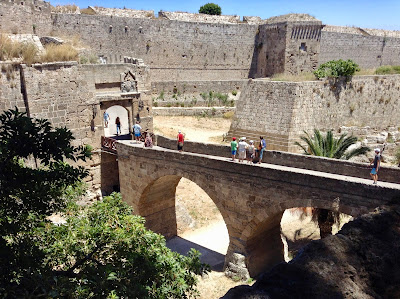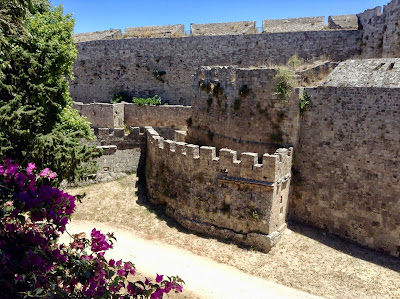Of course, you'll know if you read my ramblings regularly that I'm a bit of a music buff, so I couldn't resist calling this post after an old John Lennon album. Anyway, it's a completely appropriate title considering what it's about.
Last Tuesday I decided to take a walk around the perimeter of the Old Town, something I hadn't done in many years. It seems to me that the majority of tourists head straight for one of the gates into the interior and often fail to take in the grandeur, the immensity, the impressiveness of what the "Knights Hospitaller of Saint John" accomplished here.
In order to get a good look at the exterior of the walls, you need to walk up Papagou from the bus station (Passing the legendary Top Three Pub!) and then go left at the traffic lights, going uphill still on Ethnarchou Machariou. Actually though, before you even reach the traffic lights, you can ascend some steps (not far up the hill from the public toilets) through some fairly poorly tended undergrowth in a neglected park area, and pretty soon you get a first glimpse of the moat beneath you and the walls on the opposite side, quite near the Grand Master's Palace, which peeps menacingly at you from above the walls, demonstrating the scale of the construction work that would have been involved in the whole thing.
It's in this small park area that I came across this curious grotto, which looked like it ought to be graced by a small pond, maybe some trickling water, but was bone dry and smelling of pee and excrement. Shame, as it would otherwise be quite cooling, even photogenic...
If you want to know where this is, it's roughly within the red circle shown below:
From here you can begin to follow the moat from above until you get to the entrance to the Old Town known as the Gate D'Amboise, which is where it says Platanakia in the map section above. At this point you have to trace your steps back down to the road, pass the entrance to the gate and re-enter the park at the place which can be clearly seen at the bottom of the screen shot above too (in green). Once in the narrow park, just take the path that keeps you closest to the wall above the moat. That's when it gets really impressive.
I don't think I've ever really taken a close look at just how amazing the Old Town wall really is. I've even run around the moat during the annual Rhodes For Life charity event, but when you're jogging and trying to swig from a plastic water bottle and not bump into other runners, as well as simply trying not to die from a heart attack, you don't tend to admire the scenery all that much. Like I said above, I believe that the majority of tourists possibly don't do this walk and don't thus get to really appreciate what a huge achievement in medieval construction it really is.
The walls around the Old Town were completed around 1465. When you look at the photos below, you can't fail to wonder, as I did while meditating on the hugeness of it all, how they managed to build the whole thing in anything less than a millennium, it's that massive. The walls were built to have as smooth an outer surface as possible, to make climbing them impossible, for a start. The designers even built 'dummy' walls here and there, to confuse potential invaders trying to find a gate to batter down in order to gain access. The fact that the Knights eventually left Rhodes (in August 1522) under a mutual agreement with Suleiman the Ottoman ruler, after he'd tried on two previous occasions to take the city by force and failed, speak volumes about just how impregnable the place was. From here they went to Malta, some say under an agreement with Suleiman in which the island was granted to them as compensation. I haven't checked that out though.
Here are some more of the photos I took on Tuesday. I've included a video or two as well...
The knights were on Rhodes from 1309 until 1522 and, as I said above when you wander the park across the moat from the walls and stand and admire the whole edifice, you have to wonder at this huge accomplishment. The whole Old City has been a World heritage site since I think 1988 and is arguably the best preserved medieval town in Europe. There are others, Carcassonne in Southern France springing to mind, which although beautiful and impressive, are largely re-constructed. Apart from the odd stone here and there, this is all original and all the more amazing for it.
If you have never wandered the outer perimeter of the Old Town of Rhodes, I heartily suggest you give it a go. From the inside, where one's eye is continually distracted by so many things worth seeing, it has to be admitted, you don't get anything like the appreciation that you ought to for the phenomenal accomplishment that is the wall around the Old Town of Rhodes.
(If the videos don't work on your device, there's a link under each one to their YouTube version, which hopefully will play for you)
Last Tuesday I decided to take a walk around the perimeter of the Old Town, something I hadn't done in many years. It seems to me that the majority of tourists head straight for one of the gates into the interior and often fail to take in the grandeur, the immensity, the impressiveness of what the "Knights Hospitaller of Saint John" accomplished here.
In order to get a good look at the exterior of the walls, you need to walk up Papagou from the bus station (Passing the legendary Top Three Pub!) and then go left at the traffic lights, going uphill still on Ethnarchou Machariou. Actually though, before you even reach the traffic lights, you can ascend some steps (not far up the hill from the public toilets) through some fairly poorly tended undergrowth in a neglected park area, and pretty soon you get a first glimpse of the moat beneath you and the walls on the opposite side, quite near the Grand Master's Palace, which peeps menacingly at you from above the walls, demonstrating the scale of the construction work that would have been involved in the whole thing.
It's in this small park area that I came across this curious grotto, which looked like it ought to be graced by a small pond, maybe some trickling water, but was bone dry and smelling of pee and excrement. Shame, as it would otherwise be quite cooling, even photogenic...
If you want to know where this is, it's roughly within the red circle shown below:
From here you can begin to follow the moat from above until you get to the entrance to the Old Town known as the Gate D'Amboise, which is where it says Platanakia in the map section above. At this point you have to trace your steps back down to the road, pass the entrance to the gate and re-enter the park at the place which can be clearly seen at the bottom of the screen shot above too (in green). Once in the narrow park, just take the path that keeps you closest to the wall above the moat. That's when it gets really impressive.
I don't think I've ever really taken a close look at just how amazing the Old Town wall really is. I've even run around the moat during the annual Rhodes For Life charity event, but when you're jogging and trying to swig from a plastic water bottle and not bump into other runners, as well as simply trying not to die from a heart attack, you don't tend to admire the scenery all that much. Like I said above, I believe that the majority of tourists possibly don't do this walk and don't thus get to really appreciate what a huge achievement in medieval construction it really is.
The walls around the Old Town were completed around 1465. When you look at the photos below, you can't fail to wonder, as I did while meditating on the hugeness of it all, how they managed to build the whole thing in anything less than a millennium, it's that massive. The walls were built to have as smooth an outer surface as possible, to make climbing them impossible, for a start. The designers even built 'dummy' walls here and there, to confuse potential invaders trying to find a gate to batter down in order to gain access. The fact that the Knights eventually left Rhodes (in August 1522) under a mutual agreement with Suleiman the Ottoman ruler, after he'd tried on two previous occasions to take the city by force and failed, speak volumes about just how impregnable the place was. From here they went to Malta, some say under an agreement with Suleiman in which the island was granted to them as compensation. I haven't checked that out though.
Here are some more of the photos I took on Tuesday. I've included a video or two as well...
 |
| This shot shows how relatively few people walk the moat, sadly. |
 |
| Here it's easy to see one of those 'dummy' walls I referred to. |
 |
| This is the Ag. Athanasios Gate |
 |
| This one's taken from the bridge shown in the one above. |
The knights were on Rhodes from 1309 until 1522 and, as I said above when you wander the park across the moat from the walls and stand and admire the whole edifice, you have to wonder at this huge accomplishment. The whole Old City has been a World heritage site since I think 1988 and is arguably the best preserved medieval town in Europe. There are others, Carcassonne in Southern France springing to mind, which although beautiful and impressive, are largely re-constructed. Apart from the odd stone here and there, this is all original and all the more amazing for it.
If you have never wandered the outer perimeter of the Old Town of Rhodes, I heartily suggest you give it a go. From the inside, where one's eye is continually distracted by so many things worth seeing, it has to be admitted, you don't get anything like the appreciation that you ought to for the phenomenal accomplishment that is the wall around the Old Town of Rhodes.
(If the videos don't work on your device, there's a link under each one to their YouTube version, which hopefully will play for you)













No comments:
Post a Comment